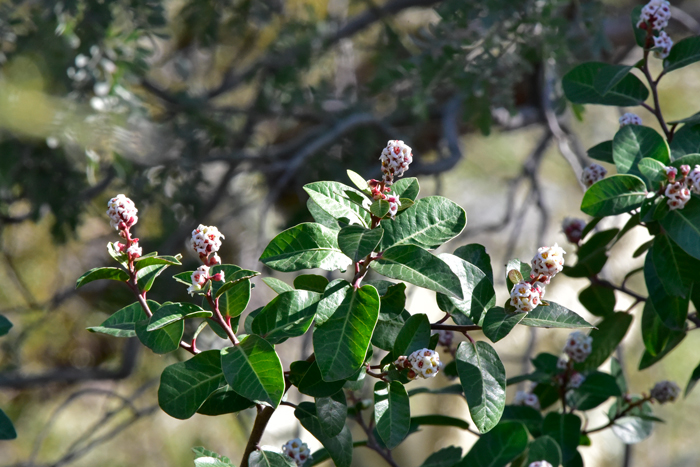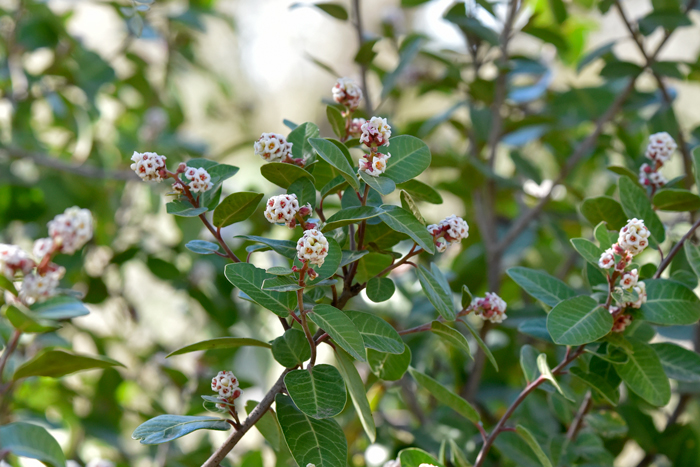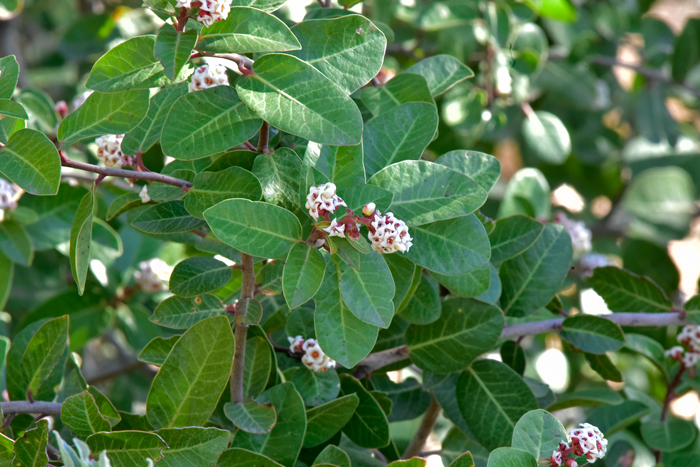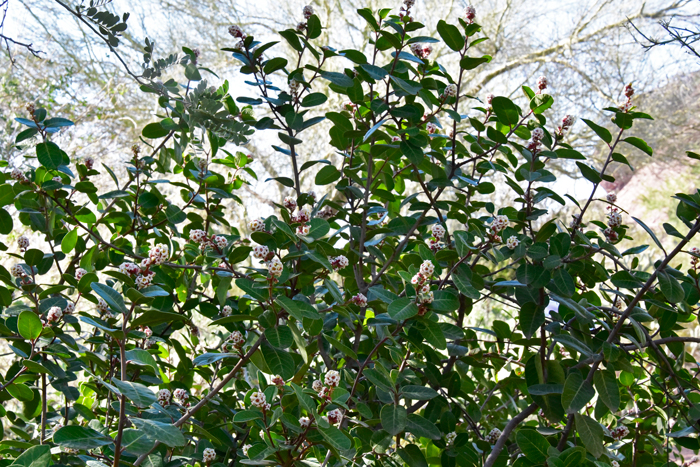Rhus kearneyi subsp. kearneyi, Kearney's Sumac




Scientific Name: Rhus kearneyi subsp. kearneyi
Common Name: Kearney's Sumac
Also Called: Kearney Sumac
Family: Anacardiaceae, Sumac Family
Synonyms: ()
Status: Native
Duration: Perennial
Size: 12 to 18 feet (3.6-5.4 m) tall.
Growth Form: Shrub or small tree; plants densely branched; bark scaly, older bark dark; branches tan to gray, young twigs and petioles reddish in color; stems and twigs densely puberulent and later glabrous.
Leaves: Green, olive green, shiny; conspicuous parallel venation (whitish) and prominent center mid-rib, glandular hairs beneath (abaxial), glabrous to sparsely hirtellous above (adaxial); alternate; evergreen; simple, margins entire to serrulate; broadly ovate, oval or broadly elliptic, leaves rounded to acuminate, the bases are rounded to cordate, leaves leathery; leaf sizes small to over 2 inches (6 cm) long, petioles .1 to .5 inches (3-10 mm) long, reddish in color.
Flower Color: White, cream or pink; clusters of flowers in dense panicles, .75 to 1.5 inches (2-4.5 cm) or more long; bracts lanceolate to ovate, glandular puberulent; flowers small, sepals pinkish, puberulent; petals cream colored, glabrous; fruit is a red drupe; lenticeular-orbicular, .4 inches long (10 mm), glandular-pubescent, viscid.
Flowering Season: January to February or March
Elevation: 1,000 to 1,500 feet (25-38 m).
Habitat Preferences: Dry cliffs in southwestern (Yuma, County), Arizona.
Recorded Range: Rhus kearneyi is found in dry cliffs in Yuma, County, Arizona; it was known from; Tinajas Altas, Cabeza Prieta, and Gila Mountains of southwestern Arizona. Now believed confined to one location (canyon) in the Tinajas Altas Mountains on the Barry Goldwater Bombing Range. It is also native to Baja California and northern Mexico.
North America & US County Distribution Map for Rhus kearneyi.
U.S. Weed Information: No information available.
Invasive/Noxious Weed Information: No information available.
Wetland Indicator: No information available.
Threatened/Endangered Information: In Arizona Rhus kearneyi is "Salvage Restricted". In the United States this species is rare and known only from a small population in Yuma, County, Arizona.
In the Southwestern United States: Arizona and Texas each have 7 species of genus, California has 5 species, Nevada has 2 species, New Mexico has 5 species and Utah has 3 species. All data approximate and subject to revision.
According to Encyclopedia of Life there are 2 sub-species in Rhus kearneyi;
Rhus kearneyi ssp, kearneyi, (one known population, located on the Barry Goldwater Bombing Range, Yuma County, Arizona;
Rhus kearneyi ssp. virginum, (unknown);
Rhus kearneyi ssp. borjaensis is a doubtful listing according to Global Biodiversity Information Facility (GBIF).
Comments: Kearney's Sumac is rare in the United States where it is limited in distribution to the southwest corner of the state in southern Yuma County, Tinajas Altas. Plants are large and showy, mostly evergreen. The type species was collected by Goldman 2311, Kearney & Harrison 6573). The canyons of northern Sonora, Mexico have species of Rhus.
In Southwest Desert Flora also see; Littleleaf Sumac, Rhus microphylla, Smooth Sumac, Rhus glabra, Sugar Sumac, Rhus ovata and Skunkbush Sumac, Rhus trilobata var. trilobata.
The species epithet "kearneyi" is named in honor of Thomas Henry Kearney. Thomas Kearney, along with Robert H. Peebles wrote "Arizona Flora", a classic botanical reference (still widely used today) to the the flora of the state.

